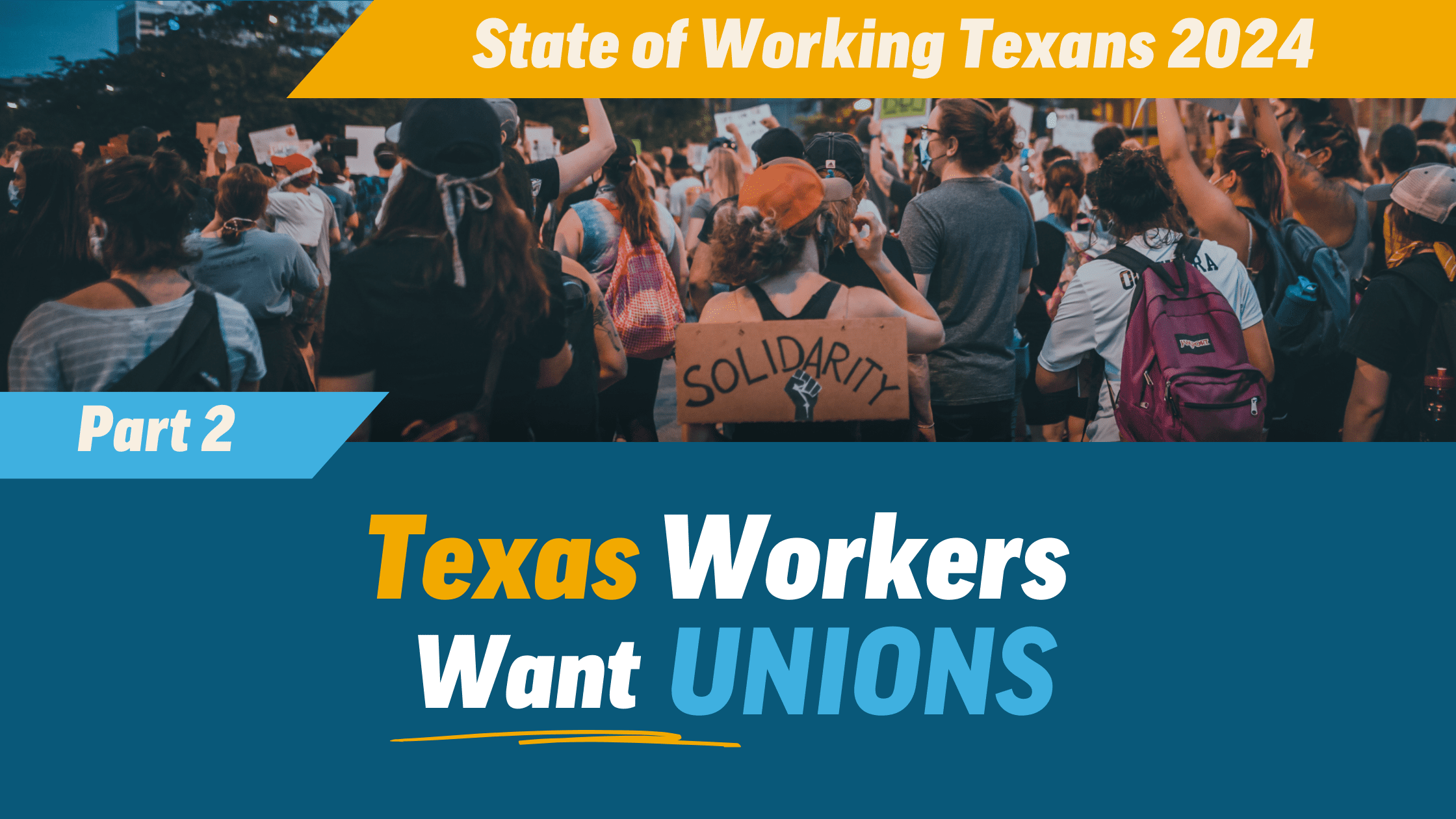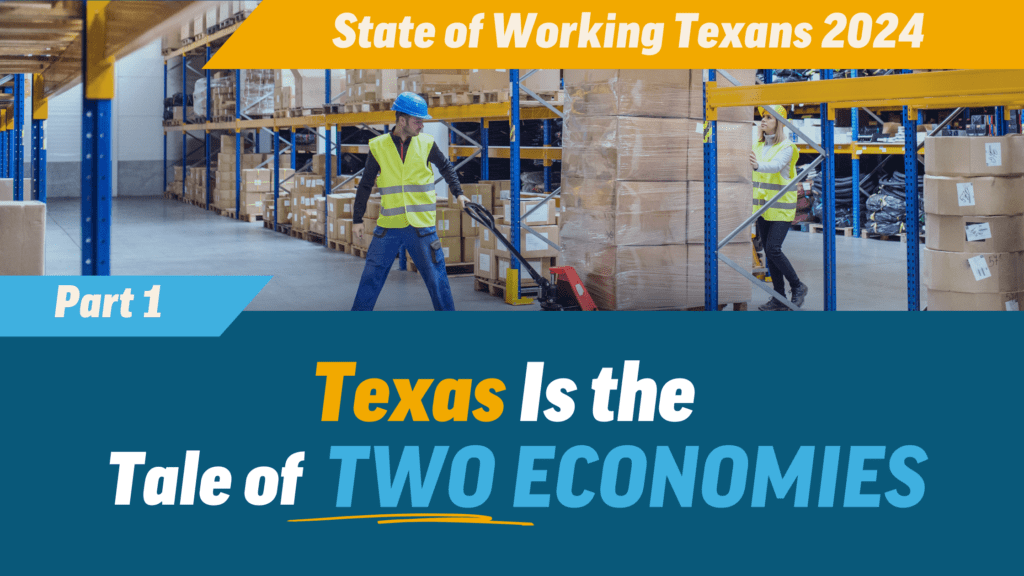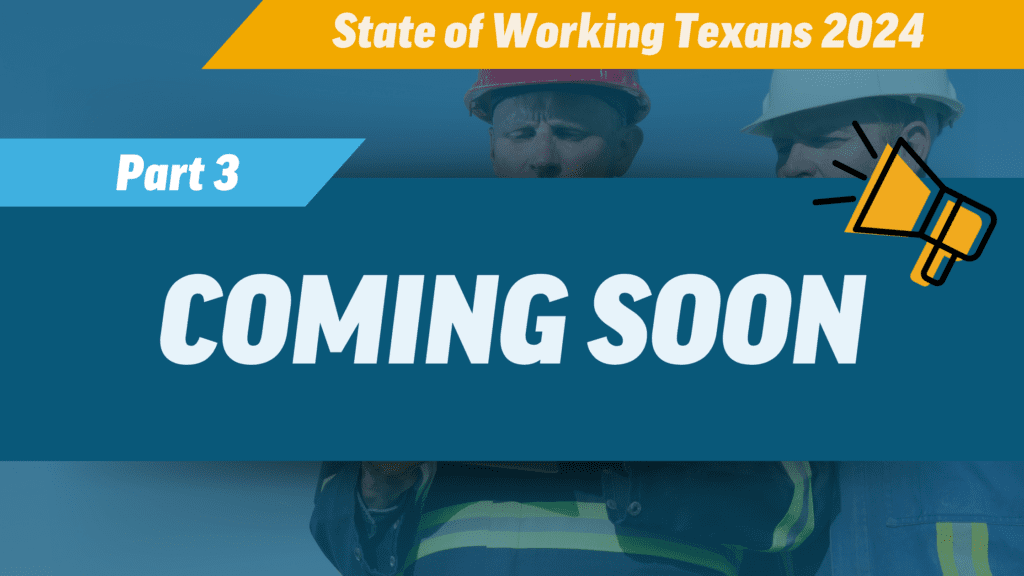Texas Workers Want Unions
Unionized Workers Build Shared Prosperity for All of Us
May 1, celebrated as May Day or International Workers’ Day, is a tribute to the relentless efforts and sacrifices of workers throughout history. Working families’ courage and commitment have secured fundamental rights that we all benefit from today. Though Texas’ rich labor history includes examples of hard-won protections, it is crucial that we confront the persistent anti-union policy barriers workers of all backgrounds face.
Unions Raise the Bar for All Working Texans
From Amarillo to Brownsville, working people are joining unions to raise wages, afford health care, and improve their chances of retirement. Through this collective action, unionized workers are looking out for our common good as their organizing efforts raise wages for all workers and strengthen our democracy. For example, states with higher union density experience less state-sponsored restrictions on voting rights. The visible rise in union organizing in Texas coincides with a rapidly widening wealth gap; today, 66 billionaires living in Texas own more wealth than 70% of Texans combined.
Even though 64% of Texans say unions are good for workers, greedy corporations and Texas’ top elected officials undermine working families by hogging the wealth that we create through policies like “right-to-work” and a state-level ban on public sector collective bargaining. These policies undermine all working families’ freedom to prosper.
Whether you work at a nonprofit, government entity, or business, you have the right to form and join a union. The more Texans who organize in the workplace, the better shot we all have at closing the widening gap between the wealthiest few and working families.
The Data Show Texas Has Worker Power Potential
Every worker, regardless of background or birth place, has the right to form and join a union. In this section, the data show Texas union workers are racially diverse and equally represented by men and women. Texas’ union density has declined since a peak in the 1970s, but the slight growth in union coverage levels and new union election petitions experienced recently may indicate a shifting long-term trend. High union density means a larger middle class.
- Membership: Data refer to members of a labor union or an employee association similar to a union.
- Representation and Coverage: Data refer to both union members and workers who report no union affiliation but whose jobs are covered by a union or an employee association contract
- Union Density: Data conveys the share of workers who are covered by a union or are union members in comparison with the total number of employed persons in that sector.
In 2023, approximately 704,000 working people in Texas were covered by a union. The long-range trend shows that the number of Texas workers covered by a union has been about the same since 1985. While union coverage levels remain relatively flat, the share or percentage of working people covered by a union – also known as union density – is an important indicator to measure worker power.
Texas’ union density is in decline due to state policies, like “right-to-work” and limited collective bargaining rights, that challenge workers’ rights to unionize. Additionally, when job growth outpaces union coverage level growth, the share of union-covered workers declines. In 2023, however, Texas added 527,000 jobs to the economy – more than any other state – while simultaneously increasing union density. This indicates real growth in the number of union workers and potentially an upward trend after years of decline and stagnation.
Texas public sector workers have higher union density than private sector workers. However, Texas’ share of public sector workers with union coverage is low when compared to the states that allow public sector collective bargaining. States with public sector worker collective bargaining rights experience higher union coverage levels and density in the public sector.
U.S. workers’ union coverage has been on the decline for decades due to policies that undermine their rights to unionize. In 2023, the U.S. experienced an increase of 191,000 union-covered workers; however, national union density did not increase because job growth outpaced worker organizing.
Black Texans experience the highest average union density, though union density for all racial and ethnic groups in Texas is on the decline. National data show Black workers’ average union density is historically higher than that of other racial groups, with Black union workers earning on average 16.4% higher wages than their non-union counterparts. One factor for this is the Civil Rights Movement, which allowed Black Americans fair access to public sector work through policy change. As the data show, there is larger union coverage in the public sector than the private sector. Black workers make up approximately 23% of our state agency workforce, while approximately 13% of all Texans are Black.
Men’s average union density is slightly higher than women’s. In 2023, the men’s national unionization rate was 11.6% whereas the women’s was 10.7%. Latinas had the highest increase in union membership that year.
Beaumont, El Paso, and Laredo are home to a higher share of unionized workers compared to Texas’ larger metropolitan areas like Houston, Dallas, and San Antonio.
The Dallas-Fort Worth metropolitan area is home to the highest number of workers with union coverage, followed by Houston.
Congress created the National Labor Relations Board (NLRB), an independent federal agency, in 1935 to enforce the National Labor Relations Act, which grants employees the right to collectively bargain. In 2023, working Texans and their unions filed the highest number of new union election petitions in 10 years. For that same duration, 2022 had the second highest number of union election petitions filed. When an employer does not voluntarily recognize their employees’ union formation, the union files a new representation election petition with the NLRB. Unfortunately, there is not a comprehensive database on voluntary recognition of unions in Texas.
When Union Membership Declines, Income Inequality Increases
The Economic Policy Institute found that national union density decreases with wealth inequality; Texas is no exception. In 1964, 13.5% of Texas workers were union members and the top 10% of earners held 36.3% of total income. In 2018, 4.3% of Texas workers were union members, a decline of 9.2 points, while the top 10% of earners increased their share of total income by 12.5 points to 48.8%. In Texas, as union membership declines, so does the percentage of wealth held by the middle class.
Another product of the national decline in union membership and coverage is that U.S. workers’ productivity continues to rise, but their wages do not keep pace. The Economic Policy Institute shows the gap that workers feel between their wallets and productivity.
Texans Support a Worker’s Right to Join a Union Even if Our Elected Officials Do Not
History shows us that “right-to-work” is a policy shaped by the wealthiest Texans who fear sharing power with a unified, multiracial working class. Vance Muse, a Texas oil tycoon, was key in creating the “right-to-work” (for less) policy that continues to undermine the freedom of working families and unions today. Muse feared unions would change Texas’ “racial order” if white and Black workers began to address their collective concerns through unions. This damaging anti-union and racist legacy persists today as our elected officials rig the rules and attack union workers’ freedoms. Texas’ wealthiest corporations and employers illegally challenge workers’ ability to form and join unions – costing all of us in the end.
Pro-Worker Policies Will Deliver Shared Prosperity for All
In order to grow Texas’ multiracial middle class and fortify our democracy, we need more unionized working families. While organizing is critical, we also need concrete policy change to achieve fairness in the system. The following are pro-family and pro-worker policy solutions that will give working families their fair share and ensure their freedom to make a good living.
Texas employers should stop using union-avoidance consultants and lawyers:
- Employers should not hire union-avoidance law firms to stop workers from exercising their right to form and join unions. The Economic Policy Institute estimates employers spend $433 million each year on union avoidance. As the data show, unions build a robust middle class; employers should not be in opposition to a stronger economy for working families.
- Employers should stop using captive audience meetings to deter employers from unionizing. Employers use captive audience meetings to push their political, religious, or anti-union views on their workers. The Texas Legislature can pass a state policy to protect a worker’s right to opt out of political and religious speech in the workplace. Eighteen states have passed policies to protect workers’ freedoms on the job.
Union notification to public sector employees enables Texans to know their rights:
- All public sector workers should receive notification from their employer on their right to join a union and collectively advocate for pay raises, better benefits, and improved working conditions. Many municipal and state employees are not aware of their right to join a union due to the state’s ban on public collective bargaining orcontract negotiations. Regardless of the ban, all public sector workers have the right to collectively advocate for pay increases and better working conditions through a union.
All workers must have collective bargaining rights: The National Labor Relations Act of 1935, which protects private sector workers’ rights to collectively bargain, excluded public sector, domestic, and agricultural workers as a concession to Southern conservative elected officials who feared desegregation.
- Public sector workers: Texas allows police and firefighters to collectively bargain on their compensation, benefits, and working conditions. However, public education staff and teachers still need collective bargaining rights in order to improve pay, working conditions, and the quality of education for Texas’ 5.5 million public school students. All public sector workers, including Texas municipal and state employees, should have the right to collectively bargain.
- Domestic and agricultural workers: Care work is systemically undervalued in Texas, leading to a shortage of workers in this sector. It’s also concerning that employers exploit agricultural workers through force, fraud, and coercion, contributing to a high incidence of labor trafficking. Collective bargaining is an important tool for workers to raise their wages; improve access to employer-sponsored benefits; and establish safe, dignified working conditions.
Reverse “right-to-work” (for less):
- Workers’ wages in “right-to-work” states are lower. The federal law already protects workers’ choice to join or not to join a union. “Right-to-work” undermines workers who pay union membership dues by allowing workers who do not pay dues to receive the benefits of a collective bargaining agreement without covering their fair share of the cost. “Right-to-work” states experience less union density, which not only means lower wages, but also less access to employer-sponsored health and retirement benefits.
- Michigan – the first state to do so in 60 years – overturned their state “right-to-work” law in 2023. Voters and their elected officials rejected “right-to-work” because the wealth gap between Michigan’s middle class and the wealthy few widened sharply upon the policy’s passage in 2012.
Texas Workers Have Fought Hard for Shared Prosperity. Policy Must Keep Pace.
Most Texans believe unions are good for working people, but many of us may not be aware of Texas’ rich labor history. Under the most hostile employer (and often state-sponsored) discrimination, Texan union members fight hard for shared prosperity and improved protections. As Texans, we can proudly point to examples of our collective labor history: Emma Tenayuca and the San Antonio pecan shellers strike in 1938; Rosa Flores and the Farah Strike of 1970; Maria Moreno with the Agriculture Workers Organizing Committee (AWOC) beginning in 1959; the International Ladies’ Garment Workers Union (ILGW) strikes (1930s-1940s) in Dallas, Laredo, and San Antonio; the Amalgamated Meat Cutters fight for food processing hygiene in East Texas in 1953; nurses’ strikes for safe, patient centered staffing in 2023, and many more. The Texas AFL CIO maintains a labor history resource page for further reading.
Texas labor activists and unionized workers courageously fight for a better quality of life for every Texan. As the data show, today more Texas workers are joining unions and claiming their freedom to thrive. Joining a union is the first step in taking back our economy from corporate greed. Equally important is our coordinated advocacy and organization for pro-worker policies that can shift the balance of power from the wealthy few into the hands of the working families driving our state’s economic prosperity.
This State of Working Texans edition research is supported by the Economic Policy Institute. Every Texan lives its values and is proudly represented by Every Texan United, a bargaining unit of the Nonprofit Professional Employees Union.


